

APRIL • VOL. 4 • SERIES OF 2023
INSIGHTS is a monthly publication of BDB LAW to inform, update and provide perspectives to our clients and readers on significant tax-related court decisions and regulatory issuances (includes BIR, SEC, BSP, and various government agencies).

DISCLAIMER: The contents of this Insights are summaries of selected issuances from various government agencies, Court decisions, and articles written by our experts. They are intended for guidance only and as such should not be regarded as a substitute for professional advice.
Copyright © 2023 by Du-Baladad and Associates (BDB Law). All rights reserved. No part of this issue covered by this copyright may be produced and/or used in any form or by any means – graphic, electronic, and mechanical without the written permission of the publisher.
What's Inside ...
- HIGHLIGHTS FOR MARCH 2023
- SIGNIFICANT COURT DECISIONS
- Supreme Court
- Court of Tax Appeals
- SIGNIFICANT REGULATORY ISSUANCES
- Bureau of Internal Revenue
- Securities and Exchange Commission
- Bangko Sentral ng Pilipinas
- Insurance Commission
- Bureau of Customs
- PUBLISHED ARTICLE
- Multiple Tax Audits
- OUR EXPERTS
- The Personalities
- The Personalities


HIGHLIGHTS for MARCH 2023
COURT OF TAX APPEALS DECISIONS
-
Only after receiving the taxpayer’s response or in case of default can the CIR issue the FAN. The fact that the taxpayer was able to timely file a protest to the FAN is of no moment. (Commissioner of Internal Revenue v. Next Mobile, Inc., G.R. No. 232055, April 27, 2022)
-
The authority accorded to the CIR under Section 204 of the NIRC is both permissive and alternative. (Service Resources, Inc. v. Commissioner of Internal Revenue, CTA EB No. 2484 (CTA Case No. 9978), March 8, 2023)
-
Under the accrual method of accounting, expenses not being claimed as deductions by a taxpayer in the current year when they are incurred cannot be claimed as deduction from income for the succeeding year. (Benchmark Marketing Corp. v. Commissioner of Internal Revenue, CTA EB No. 2212 (CTA Case No. 9296), March 10, 2023)
-
Nowhere in the Tax Code mandates that a taxpayer must obtain a prior application for zero rating for a transaction with PEZA-registered entities to be considered as zero-rated. (Commissioner of Internal Revenue v. Philippine Mining Corporation, CTA EB NO. 2579 (CTA Case No. 9763), March 14, 2023)
BIR ISSUANCES
- RMC No. 32-2023, March 16, 2023 – This prescribes the guidelines in the filing of Annual Income Tax Returns (AITR) for Calendar Year (CY) 2022 as well as the payment of corresponding taxes due thereon until April 17, 2023.
- RMC No. 36-2023, March 20, 2023 – This announces the availability of other registration-related online transactions, functions, and features in the BIR Online Registration and Update System (ORUS).
- RMC No. 40-2023, March 29, 2023 – This announces the availability of the Offline Electronic Bureau of Internal Revenue Forms (eBIRForms) Package Version 7.9.4.
SEC ISSUANCES
- SEC MC No. 1-2023, March 1, 2023 – This Circular provides for the extension of deadlines for the 2023 filing of Annual Financial Statements.
- SEC MC No. 2-2023, March 16, 2023 – This Circular provides for the grant of amnesty for non-filing or late filing of the general information sheet (GIS) and Annual Financial Statements (AFS), and non-compliance with MC No. 28, S. 2020.
BSP ISSUANCES
- BSP Memoranda No. M-2023-009, March 24, 2023 – This provides the Collection of the Annual Supervision Fees (ASF) for the Year 2023 for All Banks and Non-Banks with Quasi-Banking Functions.
- BSP Memoranda No. M-2023-010, March 24, 2023 – This provides the Collection of the Annual Supervision Fees (ASF) for the Year 2023 for All Non-Stock Savings and Loans Associations (NSSLAs) and Trust Corporations (TCs).
IC ISSUANCES
- IC Circular Letter No. CL-2023-10, March 17, 2023 – This provides the Submission of Enhanced Quarterly Reports on Selected Financial Statistics (EQRSFS).
- IC Opinion No. LO-2023-11, March 28, 2023 – This provides the Request for Legal Opinion on the Assignment of Health Maintenance Organization (HMO) Benefits.


Only after receiving the taxpayer’s response or in case of default can the CIR issue the FAN. The fact that the taxpayer was able to timely file a protest to the FAN is of no moment.
On May 4, 2009, the taxpayer received the NIC. On April 6, 2010, the taxpayer received the PAN dated March 25, 2010. Then, on April 15, 2010, the taxpayer received the FLD and FAN dated April 14, 2010. Accordingly, the taxpayer filed a Protest on May 14, 2010.
The Supreme Court held that only after receiving the taxpayer’s response or in case of default can the CIR issue the FAN. Surely, providing the taxpayer with a copy of the PAN is meaningless to the concept of due process if, after all, his right to respond to it within the prescribed period is ignored. Records show that the taxpayer received the PAN on April 6, 2010, thus the CIR should have given it until April 21, 2010 to respond. However, the FAN was served earlier on April 15, 2010 violating the taxpayer’s right to due process of law. Consequently, the FAN is void.
Finally, that the taxpayer was able to timely file a protest to the FAN is of no moment. Such does not denigrate the fact that it was deprived of statutory due process to contest the assessment before it was issued. It is a settled rule that tax assessments issued in violation of the right of the taxpayer to due process are null and void and bears no fruit. (Commissioner of Internal Revenue v. Next Mobile, Inc., G.R. No. 232055, April 27, 2022)
The CTA is not bound by the issues raised by the parties. The scope of the CTA’s review covers factual findings and the claim for refund is litigated anew at the CTA level.
During the trial for a claim for refund, the taxpayer and the BIR stipulated that there is no issue as to the amount of excise taxes paid by the taxpayer and that the issue is the legal basis of the CIR’s denial of the claim for refund. This stipulation was acknowledged by the CTA Division. Despite this, the CTA Division denied the claim, ruling that the taxpayer failed to prove the factual basis of its claim. The CTA En Banc affirmed the Decision.
The taxpayer argues that the CTA Division should not have delved into the facts and amount of excise taxes paid as it already acknowledged the stipulation of the parties and that the same should be considered a judicial admission.
The Supreme Court upheld the CTA Division’s Decision and ruled that the CTA is not bound by the issues raised by the parties. Sec. 1, Rule 14 of the RRCTA provides that in deciding cases, the CTA is not limited to issues stipulated by the parties, but may also rule upon related issues necessary to achieve an orderly disposition of the case. Whether considered a judicial admission or not, the parties’ stipulation that the basis for denial is purely legal, shall not deprive the CTA from making its own determination of facts at the judicial level. Jurisprudence dictates that the scope of the CTA’s review covers factual findings and that the claim for refund is litigated anew at the CTA level. It would have been erroneous had the CTA relied merely on such stipulation and that there was no question as to the amount of excise taxes paid when the documents supporting the taxpayer’s claim for refund clearly say otherwise. (Tanduay Distillers, Inc. v. Commissioner of Internal Revenue, G.R. No. 256740, February 13, 2023)

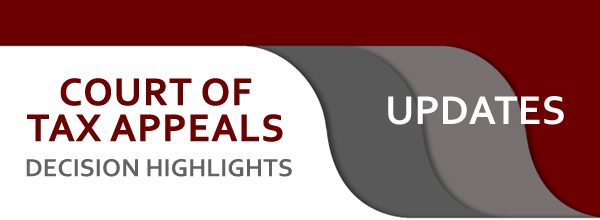
The filing of a motion for reconsideration before the Regional Director is not one of the valid remedies provided by law, hence, will not interrupt the prescriptive period.
The taxpayer received the FDDA signed by the Regional Director of Revenue Region No. 17 on February 24, 2022. On March 23, 2022, the taxpayer filed a motion for reconsideration assailing the FDDA. On March 31, 2022, the Regional Director issued a Letter-Response to the motion for reconsideration referring to the filing of a request for reinvestigation with the CIR or a judicial protest with the CTA.
On April 25, 2022, the taxpayer timely filed a motion for reconsideration dated April 18, 2022 with the CIR. The CIR, however, did not act on the motion until the lapse the 180-day period lapsed on October 22, 2022. Thus, the taxpayer appealed the disputed assessment before the CTA.
The CTA ruled that a protesting taxpayer has three options, to wit: (a) If the protest is wholly or partially denied by the CIR or his authorized representative, then the taxpayer may appeal to the CTA within 30 days from receipt of the whole or partial denial of the protest; (b) If the protest is wholly or partially denied by the CIR’s authorized representative, then the taxpayer may appeal to the CIR within 30 days from receipt of the whole or partial denial of the protest; (c) If the CIR or his authorized representative failed to act upon the protest within 180 days from submission of the required supporting documents, then the taxpayer may appeal to the CTA within 30 days from the lapse of the 180-day period.
Counting 30 days from February 24, 2022, the taxpayer can validly avail of the 2 options until March 26, 2022. Instead of availing of the 2 options above, however, the taxpayer opted to file a motion for reconsideration before the Regional Director on March 23, 2022. Such remedy is not provided for by law and, therefore, did not interrupt the running of the 30-day period prescribed above. It was only on April 25, 2022. (Pera Multi-Purpose Cooperative vs. Commissioner of Internal Revenue, CTA Case No. 11026, March 3, 2023)
It was the taxpayer’s move to its current address without informing the BIR thereof, which rendered the personal service of the assessment to the taxpayer not practicable.
Citing CIR v. BASF Coating and CIR v. Coolmate Corporation, the taxpayer argues that the notice to the BIR of its change of address need not be formal, as what is important is that the BIR becomes aware of its new address. It should be noted that while the BIR Record was not formally offered in evidence by either party, documents found in the BIR Record were used as the basis by the Court in Division in reversing its original Decision, which cancelled the subject assessment.
The CTA ruled that actual knowledge of the BIR of the taxpayer's current/new address is sufficient compliance with the written notice required under RR No. 12-85. It was the taxpayer’s move to its current address without informing the BIR thereof, which rendered the personal service of the assessment to the taxpayer not practicable. The BASF and Coolmate Ruling are inapplicable in the instant case. In BASF, prior to the mailing of the FAN/FLD, the BIR was already aware of the taxpayer’s new address. In Coolmate, there is proof that the taxpayer notified the BIR of its change of address. [Citiaire Industrial Services Corporation v. Commissioner of Internal Revenue, CTA EB No. 2511 (CTA Case No. 9713), March 7, 2023]
The authority accorded to the CIR under Section 204 of the NIRC is both permissive and alternative.
The taxpayer filed a Petition for Review with the CTA praying for a cash refund. The CTA Division granted, in the alternative, the issuance of TCC. Thus, the taxpayer appealed to the CTA En Banc claiming that the CTA Division erred in granting a relief of tax credit when it only prayed for a cash refund.
The CTA En Banc ruled that the authority accorded to the CIR under Section 204 of the NIRC is both permissive and alternative. Section 204 uses the permissive term "may" which denotes discretion and "cannot be construed as having a mandatory effect. Section 204 also uses the term "or", indicating an alternative. Undoubtedly therefore, Congress, by using the term "or" in Section 203, intended to give the CIR a choice to either credit or refund taxes erroneously or illegally received. Further, based on the administrative claim that it filed with the BIR, the taxpayer declared a claim for either refund or issuance of TCC. The taxpayer’s petition did not limit its prayer to the grant of refund as it also prayed for other reliefs, just and equitable under premises. The principle of estoppel precludes the taxpayer from asserting a different position. [Service Resources, Inc. v. Commissioner of Internal Revenue, CTA EB No. 2484 (CTA Case No. 9978), March 8, 2023]
The admitted fact that the PCL is considered as the final decision of the CIR meant the taxpayer had 30 days from its receipt to seek judicial review.
On February 9, 2009, the taxpayer filed its Protest to the FLD. On September 10, 2013, the taxpayer received the FDDA dated September 6, 2013 signed by the RD. On October 9, 2013, the taxpayer appealed the FDDA to the CIR. On April 10, 2016, the taxpayer received a letter dated March 10, 2016 from the Assistant RD informing the taxpayer that all issues stated and findings per FDDA are hereby reiterated. On April 26, 2013, the taxpayer wrote to the CIR and sought confirmation whether the letter dated March 10, 2016 of the Assistant RD was the CIR’s final decision on the matter.
Pending reply, on May 5, 2017, the taxpayer received a PCL dated April 20, 2017. On June 2, 2017, the taxpayer filed a Petition for Review. The parties included an admission of the fact that the PCL is considered as the final decision of the CIR. The CTA Division partially granted the Petition. In its appeal, the CIR argues that the CTA lacks jurisdiction as the letter dated March 10, 2016 should be considered as the FDDA appealable to the CTA.
The Court ruled that the CTA Division has jurisdiction, and the admitted fact that the PCL is considered as the final decision of the CIR may not be swept under the rug as the CIR would have it. Since the taxpayer received the PCL equivalent to the CIR’s FDDA on May 5, 2017, it had 30 days therefrom, or until June 4, 2017 to seek judicial review. Hence, the Petition for Review was seasonably filed. [Commissioner of Internal Revenue v. Cebu Light Industrial Park, Inc., CTA EB No. 2466 (CTA Case No. 9607), March 8, 2023]
It may be concluded that the person who received the LOA, PAN, and FLD has the authority to do so since the original copies reached the taxpayer.
This is a Petition for Review filed questioning the validity of the WDL. The taxpayer argues that she did not receive the LOA, PAN, and FLD, and was instead served to a person who has no authority to do so.
The Court ruled that the taxpayer received the LOA, PAN, and FLD and that the person who received the LOA, PAN, and FLD has the authority to do so since the original copies reached the taxpayer. Notably, during the trial, the taxpayer was able to present the originals for marking, and comparison with, the reproduced copies. Moreover, the taxpayer did not explain the circumstances as to how she was able to obtain the original copies of the LOA, thereby enabling her to show before the Court such original copies. Thus, the contention of the taxpayer that she did not actually receive the LOA, PAN, and FLD does not hold water. (Yap v. Bureau of Internal Revenue, CTA Case No. 10019, March 9, 2023)
Under the accrual method of accounting, expenses not being claimed as deductions by a taxpayer in the current year when they are incurred cannot be claimed as a deduction from income for the succeeding year.
The CTA Division sustained the assessment for TY 2011 based on factual circumstances. In particular, for the alleged unsupported non-VATable outside services, the taxpayer argues that the same has supporting documents. However, the CTA Division ruled that the expenses claimed as deductions in the taxable year were supported by invoices and official receipts that were dated in prior years.
The CTA En Banc ruled that while a taxpayer has the right to claim all authorized deductions during the current year, a taxpayer cannot deduct such claim in the succeeding year. RMAO No. 1-2000 provides that under the accrual method of accounting, expenses not being claimed as deductions by a taxpayer in the current year when they are incurred cannot be claimed as a deduction from income for the succeeding year. Thus, a taxpayer who is authorized to deduct certain expenses and other allowable deductions for the current year but failed to do so cannot deduct the same for the next year. The taxpayer should have claimed the expenses incurred in TYs 2009 and 2010 in the same years and not in TY 2011. The taxpayer cannot deduct the expenses incurred in TYs 2009 and 2010 from the gross income earned in TY 2011. [Benchmark Marketing Corp. v. Commissioner of Internal Revenue, CTA EB No. 2212 (CTA Case No. 9296), March 10, 2023]
Nowhere in the Tax Code mandates that a taxpayer must obtain a prior application for zero rating for a transaction with PEZA-registered entities to be considered as zero-rated.
This is a case for a claim for refund or issuance of tax credit certificate. The CIR argued that the taxpayer is required to secure an approved application for zero-rating of its sales to its customers registered with the PEZA for the same to be considered zero-rated, which in turn is necessary in order to claim a VAT refund or credit.
The CTA En Banc ruled that nowhere in the Tax Code mandates that a taxpayer must obtain a prior application for zero rating for a transaction with PEZA-registered entities to be considered as zero-rated. Jurisprudence is clear that BIR regulations additionally requiring an approved prior application for zero rating cannot prevail over the clear VAT nature of transactions with PEZA-registered entities. An effectively zero-rated transaction does not and cannot become exempt simply because an application was not made or if made was denied. (Commissioner of Internal Revenue v. Philippine Mining Corporation, CTA EB NO. 2579 (CTA Case No. 9763), March 14, 2023)
Simply put, in order for a foreign corporation may be considered engaged in trade or business, its business transaction must be continuous.
The Court in Division denied the taxpayer’s claim for refund or issuance of a tax credit certificate for the failure of the taxpayer to prove that it was not engaged in business in the Philippines. The taxpayer anchored its argument in the case of BIR v. Deutsche Knowledge Service Pte Ltd, wherein the SC ruled that SEC Certification of Non-Registration proves that an entity is a foreign corporation, while the Articles of Incorporation of the foreign client is prima facie evidence that it is not engaged in trade or business in the Philippines.
The CTA En Banc ruled that for the zero-rating of services under the Tax Code the recipient of such services must be a foreign corporation doing business outside the Philippines, among other requisites. The presentation of both Foreign Articles/Certificate of Incorporation and SEC Certificate of Non-Registration will ordinarily prove that an entity is a foreign corporation not doing business in the Philippines. However, an exception to this rule is when there is clear and convincing evidence that would prove otherwise. Here, the taxpayer failed to prove that the recipient of the services is a foreign corporation doing business outside the Philippines. Simply put, in order for a foreign corporation may be considered engaged in trade or business, its business transaction must be continuous. And such continuity may be shown by "the performance of acts or works or the exercise of some of the functions normally incident to, and in progressive prosecution of commercial gain or for the purpose and object of the business organization" and is exemplified by "the appointment of a local agent." (Amadeus Marketing Philippines, Inc. v. Commissioner of Internal Revenue, CTA EB NO. 2496, March 16, 2023.)
The signature of the taxpayer’s authorized representative must be identified and authenticated to prove that the assessment notices were duly served and received by the taxpayer.
The taxpayer argues that Assessment No. 067-06-103-341-236 is void for having been issued in violation of due process. To be specific, there was allegedly a lack of due notice to the taxpayer, as the NIC, PAN, and FLD/FAN were not received by the taxpayer or her duly authorized representative.
The Court ruled that in order to prove that the assessment notices were duly served and received by a taxpayer, there is a need for the CIR or his duly authorized representative, to also identify and authenticate signatures to ascertain whether they actually belong to the taxpayer’s authorized representative. In this case, however, when asked whether he ascertained if Rommel Braga was in fact, the taxpayer’s duly authorized representative, RO Aguinaldo merely stated that, Rommel Braga was “the only person at that office at that time” and that he did not present any form of identification card. Clearly, RO Aguinaldo’s failure to exert any effort to ascertain whether Rommel Braga is actually the person he claims to be, and if he is indeed the taxpayer’s duly authorized representative, falls short of his duty with regard to the service of the subject LOA and FLD. In fact, RO Aguinaldo even admitted that he can no longer recall how the FLD was served to the taxpayer. (Fidela D. Fernandez vs. Commissioner of Internal Revenue, CTA Case No. 9908, March 24, 2023)

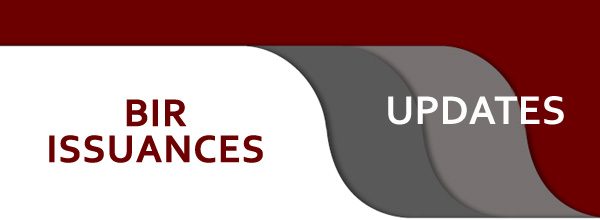
RMC No. 32-2023,
March 16, 2023
This prescribes the guidelines in the filing of Annual Income Tax Returns (AITR) for Calendar Year (CY) 2022 as well as the payment of corresponding taxes due thereon until April 17, 2023.
Taxpayers may file the AITR for CY 2022 and pay the taxes due to any Authorized Agent Banks (AABs) and Revenue Collection Officers (RCOs), notwithstanding the Revenue District Office (RDO) jurisdiction, without the imposition of penalties for wrong venue filing.
The taxpayers mandated to use the Electronic Filing and Payment System (eFPS) shall file the AITR electronically and pay the taxes due through the eFPS-AABs where they are enrolled. Likewise, the said taxpayers shall use the eBIR Forms in the filing of AITR in cases that filing cannot be made through the eFPS due to the following reasons:
a. Enrolment to BIR-eFPS and eFPS-AAB is still in process;
b. The enhanced forms are not yet available in eFPS;
c. Unavailability of BIR-eFPS covered by duly released advisory; or
d. Unavailability of eFPS-AAB system as informed by the AAB.
For electronically filed returns through the eBIR Forms, payment of taxes due may be made through any AABs or to any RCOs of the RDO or through the Electronic Payment (ePayment) gateways.
Taxpayers who will manually file AITR and pay taxes due thereon through RCOs of the RDO may pay in cash up to Twenty Thousand Pesos (Php 20,000.00) only or in check regardless of the amount. Provided that, the check shall be made payable to “Bureau of Internal Revenue”.
“No Payment AITRs” shall be filed electronically through the eBIR forms.
For electronically filed AITRs without any attachment required, printed copies of the e-filed tax returns need not be submitted to the office under the Large Taxpayers Service (LTS) / RDO. The generated Filing Reference Number from eFPS or the email confirmation from eBIR Forms will serve as the proof of filing of returns. Likewise, for electronically filed AITRs, taxpayers may submit their attachments to the BIR’s Electronic Audited Financial Statements (eAFS) System or to the LTS/RDO where the taxpayer is registered within fifteen (15) days from the date of the tax filing deadline. Only attachments will be stamped received by the LTS/RDO, printed copies of AITR need not be stamped
“Received”.
RMC No. 36-2023, March 20, 2023
This announces the availability of other registration-related online transactions, functions and features in the BIR Online Registration and Update System (ORUS).
The following are the registration-related online transactions, functions, and features in the BIR Online Registration and Update System (ORUS) starting March 17, 2023:
a. Online Payment (e-Payment) of Annual Registration Fee (RF) for New Business Registrants
b. Online Inquiry of RF Payment for BIR Internal Users
c. Application for Cancellation of Permit to Use (PTU) Loose-lease and Acknowledgement Certificate (AC) of Computerized Accounting System (CAS)
d. Online Verification of Taxpayer Identification Number (TIN)
e. BIR Registered Business Search Facility
Taxpayers who already have an existing ORUS account may avail of the additional online transaction, functions, and features by logging-in to the system by accessing it through the BIR website (www.bir.gov.ph) under the eServices icon or thru the URL https://orus.bir.gov.ph. Taxpayers who do not have an ORUS account and opted to use the said online registration facility of the BIR are required to enroll or create an account in ORUS following the guidelines prescribed under the Revenue Memorandum Circular No. 122-2022.
RMC No.40-2023, March 29, 2023
This announces the availability of the Offline electronic Bureau of Internal Revenue Forms (eBIRForms) Package Version 7.9.4.
Offline Electronic BIR Forms (eBIRForms) Package Version 7.9.4 is downloadable from www.bir.gov.ph and www.knowyourtaxes.ph/ebirforms.
It includes the April 2021 version of the following forms:
1. BIR form 1707 – Capital Gains Tax Return (For Onerous Transfer of Shares of Stock Not Traded Through the Local Stock Exchange); The deadline for filing and payment is within thirty (30) days after each cash sale, barter, exchange, or other disposition of shares of stock not traded through the local stock exchange.
2. BIR Form 1707-A - Annual Capital Gains Tax Return (For Onerous Transfer of Shares of Stock Not Traded Through the Local Stock Exchange)
For individuals, the deadline is on or before April 15 of each year covering all stock transactions of the preceding taxable year.
For a corporation, the deadline is on or before the fifteenth (15th ) day of the fourth (4th) month following the close of the taxpayer’s taxable year covering all stock transactions of the preceding taxable year.
Payment of taxes due thereon, if any, can be made either through manual payment (AAB/RDO/RCO) or online payment (LBP/ DBP/UBP).


SEC MC No. 1-2023, March 1, 2023
This Circular provides for the extension of deadlines for the 2023 filing of Annual Financial Statements.
Audited Financial Statements (AFS) of companies whose called year ends of 31 December 2022 shall be filed through the SEC Electronic Filing and Submission Tool (eFAST), as follows:
| Revised Filing Schedules | Last Digits of SEC Registration/ License Number |
| May 29 - June 2 | 1 and 2 |
| June 5 - 9 | 3 and 4 |
| June 13 – 16 | 5 and 6 |
| June 19 – 23 | 7 and 8 |
| June 26 – 30 | 9 and 0 |
Late filings or submissions after the due dates provided above shall be accepted starting 03 July 2023 and shall be subject to the prescribed penalties, which shall be computed from the date of the last day of filing stated above.
The above-revised filing schedule shall not apply to the following corporations:
• Those whose fiscal year ends on a date other than December 31, 2022.
• Those whose securities are listed in the Philippine Stock Exchange (PSE), those whose securities are not listed but are registered with the PSE, those considered as public corporations, and other entities covered under Sec.17.2 of the SCR.
• Those AFS are being audited by the Commission on Audit.
SEC MC No. 2-2023,
March 16, 2023
This Circular provides for the grant of amnesty for non-filing or late filing of the general information sheet (GIS) and Annual Financial Statements (AFS), and non-compliance with MC No. 28, S. 2020.
Covered Violations: An amnesty on the unassessed and/or uncollected fines and penalties is hereby granted to the following violations:
1. Non-filing of GIS for the latest and prior years;
2. Late filing of GIS for the latest and prior years;
3. Non-filing of AFS, including fine for its attachments (i.e., Certificate of Existence of Program/Activity, Non-Stock, Non-Profit Organization Forms), for the latest and prior years; and
4. Late filing of AFS, including fine for its attachments (i.e., Certificate of Existence of Program/Activity, Non-Stock, Non-Profit Organization Forms), for the latest and prior years.
In addition to corporations, this shall also cover associations, partnerships, and persons under the jurisdiction and supervision of the SEC that failed to comply with MC No. 28.
Validity of Amnesty: Only those who have filed an amnesty application and secured a PAF through the eFAST, and paid through the eSPAYSEC or LBP On-Coll Facility until 30 April 2023 shall be eligible for an amnesty under this Circular.


BSP Memoranda No. M-2023-009
March 24, 2023
This provides the Collection of the Annual Supervision Fees (ASF) for the Year 2023 for All Banks and Non-Banks with Quasi-Banking Functions.
This provides the Collection of the Annual Supervision Fees (ASF) for the Year 2023 for All Banks and Non-Banks with Quasi-Banking Functions.
The following guidelines shall govern the computation and collection by the Bangko Sentral Ng Pilipinas (BSP) and the payment by Banks and NBQBs of the 2023 ASF:
1. Computation of ASF for 2023
The ASF is based on the Average Assessable Assets (AAA) of the preceding year multiplied by the applicable assessment rates approved by the Monetary Board as follows:
| Type of Financial Institution | Applicable Rate |
| Universal/Commercial Banks | 1/28 of 1% |
| Digital Banks | 1/28 of 1% |
| Thrift Banks | 1/28 of 1% |
| Rural/Cooperative Banks | 1/40 of 1% |
| NBQBs | 1/28 of 1% |
BSP Memoranda No. M-2023-010, March 24, 2023
This provides the Collection of the Annual Supervision Fees (ASF) for the Year 2023 for All Non-Stock Savings and Loans Associations (NSSLAs) and Trust Corporations (TCs).
This provides the Collection of the Annual Supervision Fees (ASF) for the Year 2023 for All Non-Stock Savings and Loans Associations (NSSLAs) and Trust Corporation (TCs).
The following guidelines shall govern the computation and collection by the Bangko Sentral Ng Pilipinas (BSP) and the payment by NSSLAs and TCs of the 2023 ASF:
1. Computation of ASF for 2023
The prescribed rate for the ASF is 1/65 of 1% of its Average Assessable Assets (AAA) of the immediately preceding year or the maximum amount of ASF per AAA range, whichever is lower, but shall not exceed the maximum amount provided below:
| Total AAA of NSSLAs | Maximum Amount of Annual Fees |
| >P1.0 billion | P500,000.00 |
| >P750.0 million - P1.0 billion | P400,000.00 |
| >500.0 million - P750.0 million | P200,000.00 |
| >P250.0 million - 500.0 million | P100,000.00 |
| >P100.0 million - P250.0 million | P50,000.00 |
| Up to P100.0 million | P10,000.00 |


IC Circular Letter No. CL-2023-10
March 17, 2023
This provides the Submission of Enhanced Quarterly Reports on Selected Financial Statistics (EQRSFS).
This provides the Submission of Enhanced Quarterly Reports on Selected Financial Statistics (EQRSFS).
Section 1. Enhanced Quarterly Reports on Selected Financial Statistics
The EQRSFS for Life and Non-life shall be the new reporting template for quarterly financial statistics and investment information. It shall replace Quarterly Reports on Selected Financial Statistics and Statement of Paid-Up Capital, Reserves, and Investments.
The EQRSFS for Life and Non-life shall have two sections - Financial Statistics Section, and Capital, Reserves, and Investments Section. The Statistics and Research Division shall process the Financial Statistics Section and the Investment Services Division shall process the Capital, Reserves, and Investments Section.
Section 2. General Requirements
The EQRSFS must be submitted in excel (.xls/.xlsx) format STRICTLY using the following attached reporting templates together with the cover letter of the company/association signed by a responsible officer with a rank of at least Vice-President in PDF format attesting that the information therein is true and correct.
Section 3. Submission and access to the IC EQRSFS portal
To access the new IC EQRSFS portal and ensure that correct and updated contact information are registered, all concerned companies and associations shall submit a registration form to stat@insurance.gov.ph for each of their authorized representatives for the IC EQRSFS. A company can register a maximum of two representatives (Annex F)
IC Opinion No. LO-2023-11, March 28, 2023
This provides the Request for Legal Opinion on the Assignment of Health Maintenance Organization (HMO) Benefits.
This provides the Request for Legal Opinion on the Assignment of Health Maintenance Organization (HMO) Benefits.
Per Circular Letter No. 2017-19, both individual and corporate contract provisions contain a standard provision providing for the non-transferability of HIVIO benefits:
NON-TRANSFERABILITY. All benefits in this Agreement are not transferable or assignable, Client may not assign any of its rights or delegate any of its obligations under this Agreement without the prior written consent of HMO. HMO may assign any of its rights or delegate any of its obligations upon written notice to Client. Any purported assignment or delegation in violation of this Agreement is null and void.
Based on the above provision, the client, whether individual or corporate, may only be allowed to assign any rights under their HMO Agreement with the prior written consent of the HMO. Any assignment without the HMO's prior written consent is void.

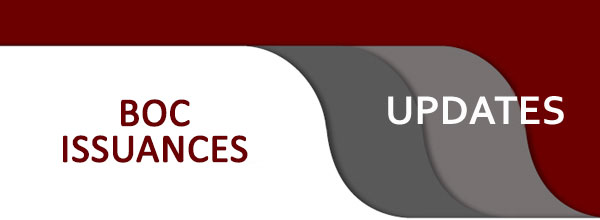
EG Memorandum No. 01-2023
Reiteration of Prohibitions Under CMO 43-2019: Implementing the Fuel Marking Program Pursuant to BOC-BIR Joint Circular No. 001-2019.
This is to reiterate for strict compliance the following salient provisions and prohibitions under CMO No. 43-2019:
Section 11.6 Prohibition on Commingling of Marked and Unmarked Fuel.
Notwithstanding the provisions of Sec. 157 of the NIRC of 1997, as amended, Marked Fuel products shall not be stored and commingled with Unmarked Fuel products.
Pursuant to Sec. 155 of the NIRC, as amended, the manufacturer/importer shall adopt a suitable accounting or metering system with the ability to accurately determine the volume of entered and withdrawn refined, manufactured or imported petroleum products.
Section 11.7 Prohibition to Export Marked Petroleum Products.
11.7.1 Locally refined or manufactured and imported petroleum products which have been fully marked with the Official Fuel Marker in accordance with provisions of these Regulations shall be deemed for domestic distribution, use or consumption within the Philippine territory.
11.7.2 No Marked Fuel, in whole, or in part shall be allowed to removed or transferred for exportation. Provided that, exportation of Marked Fuel shall be allowed if no refund of the taxes paid thereon will be availed of. Provided further, that if refund of the taxes paid thereon will be availed of, the Marked Fuel to be exported shall be diluted with the same volume of Unmarked Fuel to prevent reintroduction of the same into the country. In either case, the entity so exporting shall inform the BOC and the fuel marking provider of the intention to export Marked Fuel.

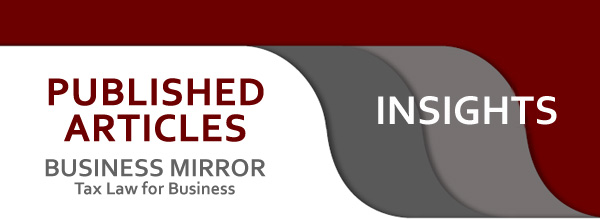
Multiple Tax Audits
By Atty. Mabel L. Buted
Taxpayers get anxious whenever they receive Letters of Authority (“LOA”) from the tax authority. This is normal because the receipt of a LOA by a taxpayer signals the conduct of a tax audit. And whenever there is audit, there is corresponding assessment for deficiency taxes. And whenever there is deficiency tax assessment, the taxpayer has to undergo the tiresome process of contesting the same, and if unsuccessful, will eventually result in the payment in full or portion of the assessment.
Taxpayers are very much familiar with the LOA issued for the conduct of a regular audit or investigation. Here, an LOA is issued in accordance with the BIR’s power to examine the tax returns of a taxpayer and to assess the correct amount of taxes due. The LOA authorizes specific BIR revenue officers to examine the taxpayer’s books of accounts and other accounting records for the taxable period indicated in the letter. Upon receipt of the letter, the taxpayer is required to make available or submit required documents, books and records for the examiners to be able to conduct the investigation. Assessment notices may then be issued containing the audit findings. In all the stages of the assessment process, the taxpayer may contest the audit findings in accordance with the remedies available to it until the issues are resolved or the taxes finally determined to be due are paid.
May a taxpayer be subjected to another round of examination for the same period?
A LOA may also be issued in cases other than in a regular tax audit. Note that the BIR has also the power to conduct inventory-taking and observation or surveillance of a taxpayer’s business operations. The BIR exercises this power if it has reason to believe that a taxpayer is not declaring its correct income, sales or receipts for internal revenue tax purposes. A Mission Order is normally issued for this purpose. If the result of the surveillance activities indicates that the veracity of the taxpayer’s accounting records is not reliable, the BIR may issue LOA, assess the taxpayer, and issue assessment notices (RMO No. 03-2009).
The taxpayer may also be audited by the BIR in instances when deficiency tax arises from incorrect information stated on the face of the tax returns, late filing of tax returns and non-payment or underpayment of taxes (RMO No. 17-2006). In these cases, Returns Processing System (RPS) Audit Results/Assessment Notices are issued to the concerned taxpayer. These are different and separate from the assessment notices issued under the regular tax audit. As a rule, the RPS Assessment Notice must also be preceded by a LOA except in cases when no preliminary assessment notice (PAN) is required, that is: when the deficiency tax is the result of mathematical error in the computation; when a discrepancy is determined between the tax withheld and the amount actually remitted by the withholding agent; when a taxpayer who opted to claim a refund or tax credit of excess creditable withholding tax has carried over the same to the succeeding taxable year; when the excise tax due has not been paid; and when the article locally purchased or imported by an exempt person has been transferred to non-exempt persons (CTA Case No. 9766, July 15, 2019).
It is then possible that a taxpayer may receive more than one LOA for the same taxable year under the different powers of the BIR. The current system and procedures of the BIR apparently makes multiple tax audits possible.
It is not then surprising when we hear taxpayers worrying when they receive assessment notices after a Mission Order while a regular tax audit is on-going. Some also complain when RPS Audit Results/Assessment Notices are issued requiring taxpayers to pay penalties for alleged late payment of taxes for a particular period, even after the regular tax audit for the same period was already completed and terminated.
Why can’t the taxpayer be subjected to tax audit only once? Shouldn’t all deviations from compliance be covered in one audit?
In case of multiple tax audits, what can taxpayers do? Taxpayers may seek relief from the tax court by questioning the issuance of the other LOAs and assessments emanating from the LOAs. A LOA may be invalidated if it covers the same taxable period that was previously investigated by the BIR under another LOA (CTA Case No. 10618, March 6, 2023).
The conduct of multiple tax audits are among the areas that need to be reviewed for the protection of the taxpayers. As our laws are being reviewed, I hope that this area should also be given the same attention.
----------------------------------------------
For inquiries on the article, you may call or email
ATTY. MABEL L. BUTED
Junior Partner
T: +63 2 8403 2001 loc. 160
mabel.buted@bdblaw.com.ph


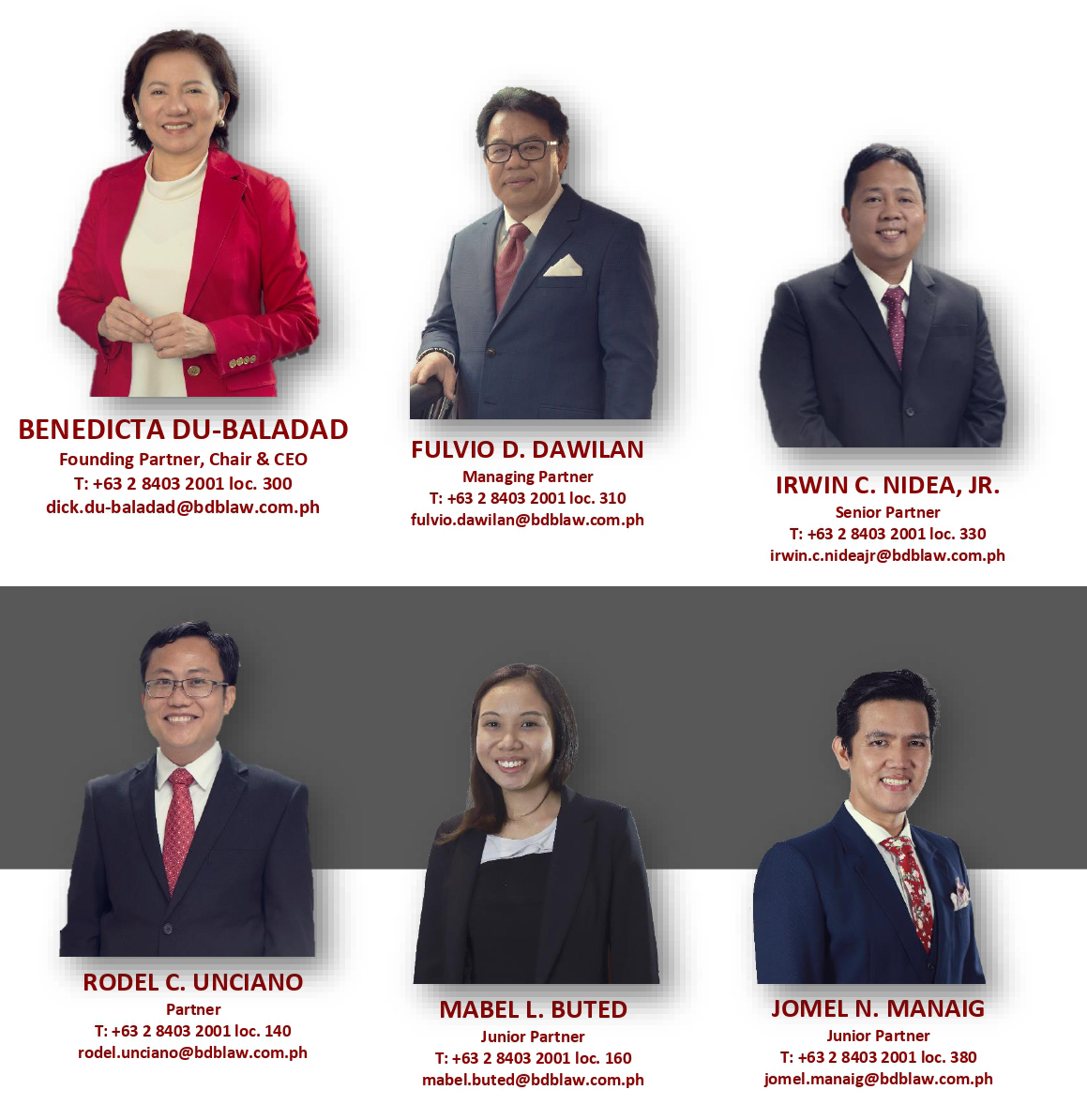
DISCLAIMER: The contents of this Insights are summaries of selected issuances from various government agencies, Court decisions and articles written by our experts. They are intended for guidance only and as such should not be regarded as a substitute for professional advice.
Copyright © 2023 by Du-Baladad and Associates (BDB Law). All rights reserved. No part of this issue covered by this copyright may be produced and/or used in any form or by any means – graphic, electronic and mechanical without the written permission of the publisher.





